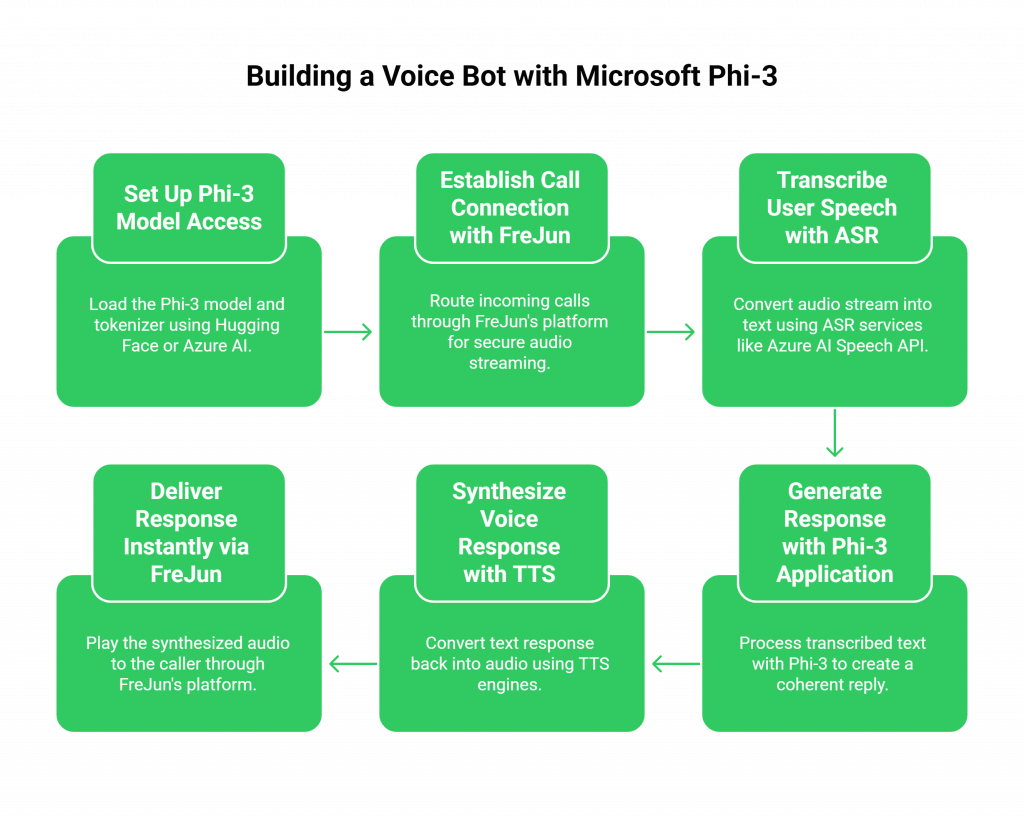For years, the story of artificial intelligence was one of ever-increasing scale. The pursuit of greater intelligence led to massive, resource-intensive models that, while powerful, were often impractical for widespread business use. The cost and complexity of running these behemoths placed them out of reach for many. Today, the narrative is changing. The AI revolution is getting practical, thanks to the emergence of powerful Small Language Models (SLMs).
Table of contents
- The Production Wall: Where Efficient AI Meets Inefficient Infrastructure
- FreJun: The Enterprise-Grade Voice for Your Efficient AI
- The Core Technology Stack for a Production-Ready Voice Bot
- How to Build a Voice Bot Using Microsoft Phi-3?
- DIY Infrastructure vs. FreJun: A Head-to-Head Comparison
- Best Practices for Optimizing Your Phi-3 Voice Bot
- From Efficient Model to Tangible Business Asset
- Frequently Asked Questions (FAQs)
Leading this new wave is Microsoft’s Phi-3. As a highly capable SLM, Phi-3 delivers impressive conversational quality and instruction-following abilities in a much smaller, more efficient package. This breakthrough makes it feasible for businesses of all sizes to build genuinely intelligent agents for customer support. The challenge, however, has now shifted. The problem is no longer the accessibility of the AI “brain”; it’s the complexity of giving that brain a voice.
The Production Wall: Where Efficient AI Meets Inefficient Infrastructure
The excitement around an efficient model like Phi-3 often inspires development teams to build impressive demos. The bot works flawlessly in a controlled lab environment, taking input from a laptop microphone and responding with remarkable intelligence. But a massive chasm separates this local demo from a scalable, production-grade voice bot that can handle real customer calls. This is the production wall, and it’s where most voice AI projects fail.

When a business tries to deploy their AI over the phone, they run headfirst into daunting technical challenges:
- Crippling Latency: The delay between a caller speaking and the bot responding is the number one killer of a natural conversation. High latency leads to awkward pauses, interruptions, and a frustrating user experience.
- Integration Complexity: A complete voice solution requires stitching together multiple real-time services: Automatic Speech Recognition (ASR), the Phi-3 model itself, and a Text-to-Speech (TTS) engine. Orchestrating this pipeline seamlessly is a major engineering hurdle.
- Scalability and Reliability: A system that works for one call will collapse under the pressure of hundreds of concurrent calls. Ensuring high availability and crystal-clear audio requires a resilient, geographically distributed network, which is incredibly expensive and complex to build and maintain.
This infrastructure problem is the primary reason promising voice AI projects stall, consuming valuable resources on “plumbing” instead of perfecting the AI.
FreJun: The Enterprise-Grade Voice for Your Efficient AI
This is precisely the problem FreJun was built to solve. We believe that businesses should be able to leverage the best AI models, large or small without having to become telecommunications experts. FreJun handles the complex voice infrastructure so you can focus on building your AI.
Our platform serves as the critical bridge between your Phi-3 application and the global telephone network. We provide a robust, developer-first API that manages the entire voice layer, from call connection to real-time audio streaming. By abstracting away the complexity of telephony, we enable you to turn your efficient, text-based Phi-3 model into a powerful, production-ready Voice bot using Microsoft Phi-3.
The Core Technology Stack for a Production-Ready Voice Bot
A modern voice bot is a pipeline of specialized services working in harmony. For a bot powered by Phi-3, a typical high-performance stack includes:
- Voice Infrastructure (FreJun): The foundational layer. It connects to the telephone network, manages the call, and streams audio to and from your application in real-time.
- Automatic Speech Recognition (ASR): A service that transcribes the caller’s raw audio into text. Given Phi-3’s origin, Microsoft’s own Azure AI Speech services are a natural fit here.
- Conversational AI (Microsoft Phi-3): The “brain” of the operation. The microsoft/Phi-3-mini-4k-instruct model is ideal for this, accessed via Hugging Face or Azure AI.
- Text-to-Speech (TTS): A service like Azure’s Text-to-Speech with neural voices that converts the AI’s text response into natural-sounding speech.
FreJun is model-agnostic, giving you the freedom to assemble your preferred stack while we handle the most complex and critical piece: the voice transport layer.
How to Build a Voice Bot Using Microsoft Phi-3?
While many tutorials start with a Jupyter notebook, a real business application starts with a phone call. This guide outlines the production-ready pipeline for creating a Voice bot using Microsoft Phi-3.

Step 1: Set Up Your Phi-3 Model Access
Before your bot can think, its brain needs to be running.
- How it Works: Load the microsoft/Phi-3-mini-4k-instruct model and tokenizer using the Hugging Face Transformers library in your Python application. For production, you would typically host this on a cloud server with GPU acceleration. Alternatively, you can access it via an Azure AI endpoint.
Step 2: Establish the Call Connection with FreJun
This is where the real-world interaction begins.
- How it Works: A customer dials your business phone number, which is routed through FreJun’s platform. Our API establishes the connection and immediately begins providing your application with a secure, low-latency stream of the caller’s voice.
Step 3: Transcribe User Speech with ASR
The raw audio stream from FreJun must be converted into text.
- How it Works: You stream the audio from FreJun to your chosen ASR service, like the Azure AI Speech API. The ASR transcribes the speech in real time and returns the text to your application server.
Step 4: Generate a Response with Your Phi-3 Application
The transcribed text is fed to your Phi-3 model.
- How it Works: Your application takes the transcribed text, appends it to the ongoing conversation history for context, and sends it all as a prompt to your Phi-3 API endpoint. The model’s instruction-following capabilities will then generate a relevant, coherent, and helpful reply.
Step 5: Synthesize the Voice Response with TTS
The text response from Phi-3 must be converted back into audio.
- How it Works: The generated text is passed to your chosen TTS engine. To maintain a natural flow, it is critical to use a streaming TTS service that begins generating audio as soon as the first words of the response are available.
Step 6: Deliver the Response Instantly via FreJun
The final, crucial step is playing the bot’s voice to the caller.
- How it Works: You pipe the synthesized audio stream from your TTS service directly to the FreJun API. Our platform plays this audio to the caller over the phone line with minimal delay, completing the conversational loop of your Voice bot using Microsoft Phi-3.
DIY Infrastructure vs. FreJun: A Head-to-Head Comparison
When building a Voice bot using Microsoft Phi-3, you face a critical build-vs-buy decision for your voice infrastructure. The choice will define your project’s speed, cost, and ultimate success.
| Feature / Aspect | DIY Telephony Infrastructure | FreJun’s Voice Platform |
| Primary Focus | 80% of your resources are spent on complex telephony and network engineering. | 100% of your resources are focused on building and refining the AI conversational experience. |
| Time to Market | Extremely slow (months or even years). Requires hiring a team with rare and expensive telecom expertise. | Extremely fast (days to weeks). Our developer-first APIs and SDKs abstract away all the complexity. |
| Latency | A constant and difficult battle to minimize the conversational delays that make bots feel robotic. | Engineered for low latency. Our entire stack is optimized for the demands of real-time voice AI. |
| Scalability & Reliability | Requires massive capital investment in redundant hardware, carrier contracts, and 24/7 monitoring. | Built-in. Our platform is built on a resilient, high-availability infrastructure designed to scale with your business. |
| Maintenance | You are responsible for managing carrier relationships, troubleshooting complex failures, and ensuring compliance. | We provide guaranteed uptime, enterprise-grade security, and dedicated integration support from our team of experts. |
Best Practices for Optimizing Your Phi-3 Voice Bot
Building the pipeline is the first step. To create a truly effective Voice bot using Microsoft Phi-3, follow these best practices:
- Master Prompt Engineering: The quality of your prompts directly impacts the quality of the Phi-3 model’s responses. Design your system prompts and conversation structure to guide the bot’s tone, personality, and relevance.
- Manage Conversation State: Efficiently managing the session state is key to maintaining context in multi-turn dialogues. Ensure your application correctly stores and sends the full conversation history with every prompt.
- Implement Fallback Logic: No AI is perfect. Plan for scenarios where the bot gets confused or the ASR mis-transcribes. Implement a clear escalation path to a human agent, and manage it seamlessly with FreJun’s call routing features.
- Test in Real-World Conditions: Move beyond testing with clean audio. Use real phone calls and test with diverse accents, background noise, and varying connection quality to ensure your Voice bot using Microsoft Phi-3 is robust and reliable.
From Efficient Model to Tangible Business Asset
The availability of powerful and efficient SLMs like Microsoft’s Phi-3 presents a transformative opportunity for businesses. But a powerful AI is not, by itself, a business solution. It needs to be connected, reliable, and scalable. It needs a voice.
By building on FreJun’s infrastructure, you make a strategic decision to bypass the most significant risks and costs associated with voice AI development. You can focus your valuable resources on what you do best: creating an intelligent, engaging, and valuable customer experience with your custom Voice bot using Microsoft Phi-3. Let us handle the complexities of telephony, so you can build the future of your business communications.
Further Reading – Add a Voicebot Contact Center Workflow to Your App
Frequently Asked Questions (FAQs)
Phi-3 is a series of “small language models” (SLMs) from Microsoft. They are highly efficient and powerful, making them an excellent choice for building cost-effective, responsive AI applications like customer support voice bots.
No. FreJun is the specialized voice infrastructure layer. Our platform is model-agnostic, meaning you bring your own AI model (like Phi-3), Automatic Speech Recognition (ASR), and Text-to-Speech (TTS) services. This gives you complete control and flexibility.
While Azure AI Speech services naturally pair with a Microsoft model for ASR and TTS, they are not strictly require. You can load the Phi-3 model from Hugging Face and use any ASR/TTS provider. FreJun provides the agnostic voice layer to connect them all.
The Phi-3 Mini model supports a 4K token context window. This is sufficient for maintaining context in most standard customer support conversations.
Low latency is essential for a natural conversation. Long delays between a user speaking and the bot replying create awkward silences and lead to users interrupting the bot, causing a frustrating and ineffective experience.
